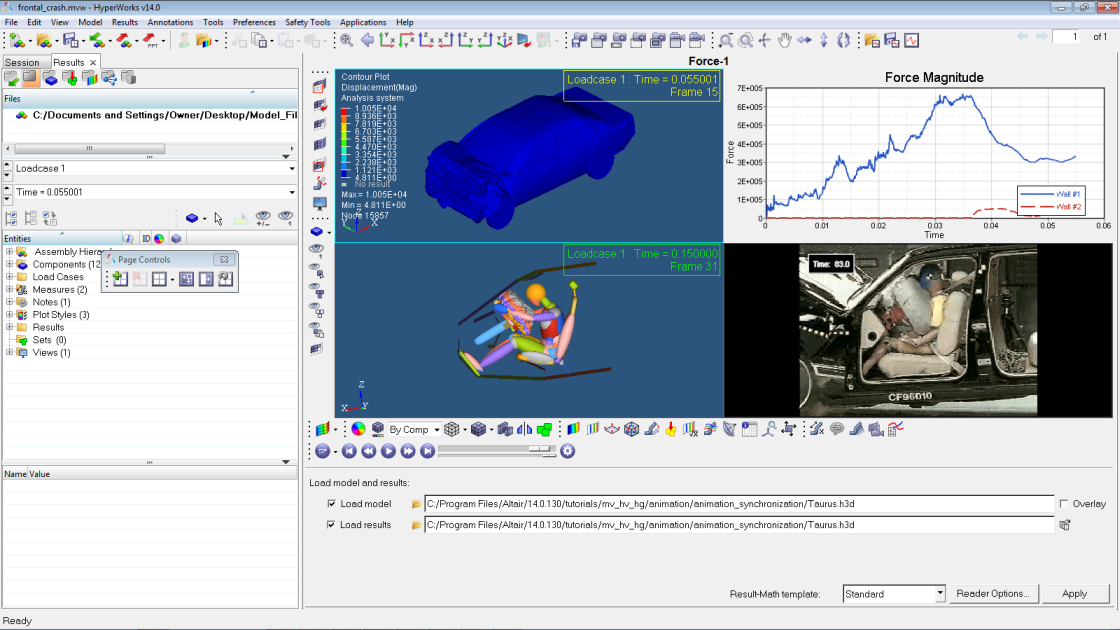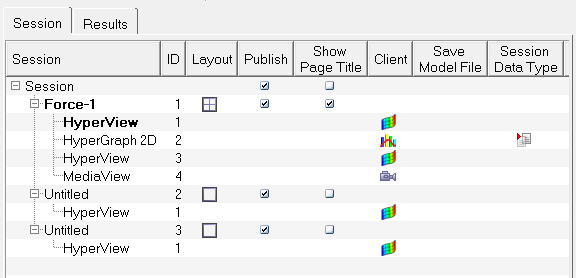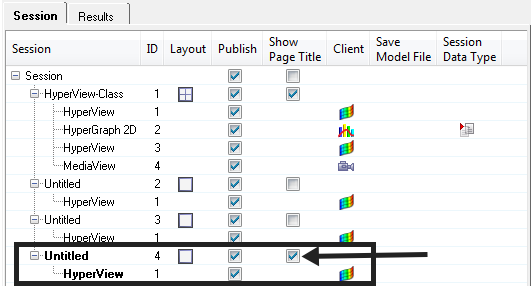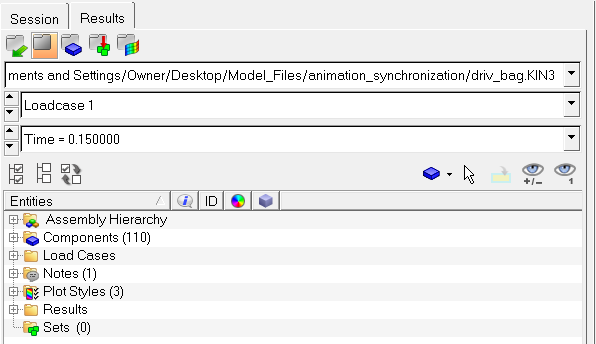HWD-0010: HyperWorks Desktop Environment |

|

|

|

|
|
HWD-0010: HyperWorks Desktop Environment |

|

|

|

|
This tutorial contains:
| • | Elements of the graphical user interface (GUI) features |
| • | Page and window controls |
| • | HyperWorks Desktop files |
Introduction
HyperWorks Desktop belongs to the HyperWorks software suite and consists of the following applications. A brief description of each product in HyperWorks Desktop is included under the Select application Menu topic. For more detailed information on a product listed below, click on the link to display the product's introductory help page.
While MotionView allows you to create and set up an analysis for multi-body systems, the remaining applications provide an interactive and easy to use environment for the visualization, plotting, study, analysis, and presentation of engineering result data obtained from finite element analysis (FEA) or multi-body dynamics (MBD) solvers.
Elements of the Graphics Interface
The main elements of the HyperWorks Desktop graphics interface are described below.
Title bar |
The title bar tells you which product is active. Because you can switch between clients, clicking on and activating a different window may change the information in the title bar. The title bar also tells you the name of the file currently loaded. In HyperMesh, the name of the active loaded user profile is also shown. |
Menu bar |
Windows style pull-down menus that allow you to access the HyperWorks Desktop functions and tools are located along the top of the screen. The top-level menu choices vary, based on the active application in the current window. |
Toolbar |
Panels containing tools associated with the active application can be accessed using the toolbar buttons. Panels are also accessible from the menu bar. See Select Application Menu for the various toolbar types. |
Tab area |
The portion of the graphical user interface that contains the browsers, the utility menus for the solver interfacing user profiles, and other functionality not shown in the panel area. The Tab Area can be moved to either the left or right side of the graphics area, or both, or it can be hidden completely. |
Graphics area |
Models, plots, animations, and text are displayed in this area. It can be divided into multiple windows. |
Panel area |
Most operations are perfomed using the panel options. |
View controls |
Tools that control the orientation of the window display. |
Select application menu |
This menu allows you to change the active HyperWorks Desktop application in any window. The options are: HyperMesh, HyperView, HyperGraph, HyperGraph 3D, MediaView, TextView, MotionView. A description for each application is included below. |
Page and window controls |
These toolbar buttons allow you to control the page and window layout. See Page and Window Controls below for more information. |
You can select one of the following applications from the Select application menu. Loading each application changes the toolbar and menu bar settings. The table below describes the purpose of each application and shows the changes in their corresponding tool bar.
Analyze product design performance in a highly interactive and visual environment.
![]()
Visualize CAE results. Deformed, linear static, modal, and transient animations for finite element and multi-body analyses are supported.
![]()
Analyze and plot data.
![]()
Create and analyze 3-D plots.
![]()
MotionView
Pre-process, post-process, and visualize mechanical system simulations, including industry-leading capabilities for flexbodies.
![]()
Read video files.
![]()
View and edit text files. In this window, you can embed mathematical functions using the Templex language. Also, you can access xy data from a plot window and perform mathematical operations on it using Templex functions.
![]()
TableView
Creates an Excel-like spreadsheet inside of HyperWorks Desktop. You can use Templex expressions inside of a cell to synchronize with HyperGraph and create summary tables that update accordingly using report templates. Value-dependent formatting allows for the easy detection of critical key point indicators (KPI's). Basic spreadsheet functionality to format and edit the table cells is also available.
![]()
The following buttons are displayed for all HyperWorks Desktop applications, and are used to manage pages, change page layouts, and manipulate individual windows:

|
Add Page |
Adds a new page to the session. |
|
Delete Page |
Deletes a page from the session. |
|
Page Layout |
Displays a pop-up menu containing 20 page layouts that can be applied to the displayed page. |
|
Expand/Reduce Window |
In a multi-window display, use this feature to enlarge or reduce the selected window. |
|
Swap Windows |
In a multi-window display, use this feature to rearrange window order. |
|
Page counter |
Displays the current page number and the number of pages in the current session in the upper right corner of the screen. You can enter a page number directly to access that page. Note The page counter is located near the upper right side of the graphical user interface. |
|
Next Page |
Browse forward through the pages. Note This arrow is located near the upper right side of the graphical user interface. |
|
Previous Page |
Browse backward through the pages. Note This arrow is located near the upper right side of the graphical user interface. |
The view controls, located in the toolbar area of the panel, allow you to visually manipulate model graphics, plots, and videos. There are three view control toolbars in HyperWorks Desktop: Standard Views, 3D View Controls, and 2D View Controls. The toolbars can be turned on or off from the View menu. A check mark indicates that a toolbar is currently displayed. Clicking an item in the Toolbars sub-menu toggles the state between "on" and "off". Like the toolbar buttons, the view controls available vary based on the current application.
Toolbars can be moved and "docked" to any of several possible locations inside the user environment. Each toolbar has a toolbar handle,  , used to drag a toolbar on (docked) or off (undocked) a toolbar area. To move a toolbar, simply click-and-drag the handle to the new location that you wish the toolbar to reside.
, used to drag a toolbar on (docked) or off (undocked) a toolbar area. To move a toolbar, simply click-and-drag the handle to the new location that you wish the toolbar to reside.
The tables below explains the functionality of the view control buttons in MotionView, HyperView, and HyperGraph:
The Standard Views toolbar provides shortcuts to commonly used viewing angles.

Function |
Icon |
Description |
Fit Model |
|
Left click: Fit model Right click: Fit all models |
Previous View |
|
Set the view as the previous view |
XY Top Plane View |
|
Set the view to the xy top plane |
XY Bottom Plane View |
|
Set the view to the xy bottom plane |
XZ Left Plane View |
|
Set the view to the xz left plane |
XZ Right Plane View |
|
Set the view to the xz right plane |
YZ Rear Plane View |
|
Set the view to the yz rear plane |
YZ Front Plane View |
|
Set the view to the yz front view |
Isometric view |
|
Set the view to the isometric view |
Reverse View |
|
Set the view to the "reverse" of the current view |
User views |
|
Set/Retrieve the currently memorized user view |
The 3D View Control toolbar provides enhanced options when viewing models in 3D.

Function |
Icon |
Description |
Zoom |
|
Zoom in/out with a factor of 2x |
Circle/Dynamic Zoom |
|
Left click: Circle zoom mode Right click: Dynamic zoom mode |
Dynamic Rotate/Spin |
|
Left click: Dynamic rotate mode Right click: Dynamic spin mode |
Pan |
|
Left click: Pan mode Right click: Center model mode |
Rotate Left/Right |
|
Left click: Rotate left Right click: Rotate right |
Rotate Up/Down |
|
Left click: Rotate up Right click: Rotate down |
Rotate clockwise/counter-clockwise |
|
Left click: Rotate clockwise Right click: Rotate counter-clockwise |
The 2D View Control toolbar provides enhanced options when viewing models in 3D.

Function |
Icon |
Description |
Fit |
|
Fit all data within viewable graphics area |
|
|
Fit x data only within viewable graphics area |
|
|
Fit y data only within viewable graphics area |
Zoom |
|
Left click: Zoom in Right click: Zoom out |
Pan horizontal |
|
Left click: Pan left Right click: Pan right |
Pan vertical |
|
Left click: Pan up Right click: Pan down |
Pan diagonal |
|
Left click: Pan diagonal upper left Right click: Pan diagonal upper right |
Pan diagonal |
|
Left click: Pan diagonal lower left Right click: Pan diagonal lower right |
Reverse view |
|
Flip x and y data |
User view |
|
Set/Retrieve the currently memorized user view |
HyperWorks Desktop Files
Each time a HyperWorks Desktop application is launched, a new session is started. Saving a session creates a session (MVW) file, which allows you to retain many of the actions you performed during the session. You can then close the session and restart it later without having to redo procedures. This file has an .mvw extension.
An MVW file is a plain text file that contains commands that were performed in the operations of the corresponding session. Results and model file data are not stored in this file. Rather, soft links point to the data files used in the session, helping to keep the MVW file size small. If you move the data files to a different folder, the MVW file will not be able to locate them unless you edit the file path names in the MVW file. It is suggested that you save the MVW file to the same folder that contains the data files. You can edit the MVW file using a text editor.
To save a session to a session file, select Save Session File from the File menu on the menu bar. To open the file select Open from the File menu.
The preference file is a script file that is read each time a HyperWorks Desktop application is started. It specifies default user settings such as the window type, printer, page layout, the autosave interval, and the order in which colors are assigned.
A standard preference file for all HyperWorks Desktop applications exists in the installation directory and is read every time HyperView is started. On Windows, the file is named preferences.mvw, while on UNIX, it is named .preferences.mvw. An additional preference file can be created in your working folder that either overwrites the standard preference file or adds it to the existing settings in the standard preference file.
A set of seven include preference files are contained in the installation. These files are customized for each HyperWorks Desktop application. They are called from the standard preference file when a session is started, and cannot be called independently. These files are located at <installation directory>/hw/prefinc. For more information see Preference File Location.
Exercise: Learning to Use the HyperWorks Desktop Interface:
In this exercise, you will:
| • | Work with session files. |
| • | Develop an understanding of the GUI. |
| • | Use the page and window controls. |
Step 1: Open the session file frontal_crash.mvw.
| 1. | From the File menu, select Open > Session. |
| 2. | Select the file frontal_crash.mvw, located in the ../tutorials/mv_hv_hg/animation directory and click Open. |

A HyperWorks Desktop page featuring multiple windows with different applications
Step 2: Add pages and navigate between them using the Page controls.
| 1. | Click the Add Page button, |
Observe the changes to the page counter.
| 2. | Add one more page. |
| 3. | Click the icons, |
You can also enter the page directly in the page number field.
![]()
| 4. | Go to page 1. |
Step 3: Using the Session Browser to rename a page and using the View menu to navigate between pages.
| 1. | Click the Session tab. |

Session Browser
| 2. | Right click on Force-1 and select Rename. |
| 3. | Type HyperView-Class, to rename page 1. |
| 4. | Right click in the Session Browser and select Create. This adds a fourth page. |
The new page is displayed as Untitled.
| 5. | Double-click the page in the Session Browser to switch to page 4. |
| 6. | To display the name of page 4 at the top of its page, from the View menu, select the Page > Title or you can check the box for Show Page Title in the Session Browser. |

| 7. | To display page 2, right click on Untitled (with the ID "2") in the Session Browser and select Make Current. |
Step 4: Use Page Layout to create a four window layout.
| 1. | Click the arrow next to the Page Layout button, |
| 2. | Click the four window layout |
The border of the upper left window in the four-window layout is cyan to indicate it is the active window.
Step 5: Change the applications in windows 2-4 on page 2.
| 1. | From page 2, click in the upper right window (window 2) to make it active. A cyan border is displayed around window 2, indicating that it is the active window on the page. |
| 2. | From the Select application menu, select HyperGraph 2D to change the window type for window 2 from animation to plot. |
The toolbar changes to reflect the plot window mode.
| 3. | Activate window 3. |
| 4. | Change the window type for window 3 from HyperView to MotionView. |
| 5. | Click on window 4 to make it active. |
| 6. | Change the window type for window 4 from HyperView to MediaView. |
| 7. | Go to page 1. |
Step 6: Use Swap Windows to change the order of windows on page 1.
| 1. | Change the page to page 1. |
| 2. | Activate window 2 (plot window). |
| 3. | Click the Swap Windows button |
| 4. | Click on window 3 in the drop down image. |
The contents of windows 2 and 3 are exchanged.
When there are only two windows on a page and you click the Swap Windows button, the windows are automatically swapped.
Step 7: Expand window 2 to the graphics area.
Use the Expand/Reduce Window button to temporarily expand the HyperView window to fill the entire graphics area. This allows you to see a larger view of the model without changing the window layout.
| 1. | Make window 2 (dummy model) active. |
| 2. | Click the Expand/Reduce Window button, |
The Expand/Reduce Window button changes to ![]() . This button acts as a toggle.
. This button acts as a toggle.
| 3. | Click the button again to return to the original display. |
| 4. | From the tab area, click the Results tab. |
| 5. | Click the Model view icon, |

Step 8: Use the view controls.
| 1. | From the View menu, select Toolbars > HyperWorks > Standard Views or 3D View Controls to remove the checkbox next to the menu item and turn the toolbars off. |
| 2. | Turn the toolbars on again. |
| 3. | Dock the toolbars by selecting the toolbar handle,  , and dropping it in the graphics area. , and dropping it in the graphics area. |
| 4. | Click the bar again to display the view controls. |
| 5. | Use the |
| 6. | Rotate the model clockwise and counter clockwise by left and right clicking on |
| 7. | Use the |
Each mouse-click rotates the model by 30 degrees.
| 8. | Use |
| 9. | Use the |
| 10. | Click |
| 11. | Click |
| 12. | In the Results Browser, right click and select Create > View. |
This saves the current view so that it can be recalled in the future.
| 13. | Rotate the model to a new position. |
| 14. | Expand the Views folder in the Results Browser and select the icon before View 1. |
This restores the saved view.
Step 9: Save the session to a session file.
| 1. | From the File menu, select Save As > Session. |
| 2. | Specify a path and the name practice for the MVW file and click Save. |
Step 10: Clear the data from the session.
| 1. | From the File menu, select New > Session. |
| 2. | Answer Yes to the pop-up message "This operation will discard current session file data. Continue?". |
Step 11: Open the session file practice.mvw.
| 1. | Open the session file practice.mvw (See step 1). |
| 2. | Notice the contents of the session. It contains the number of pages and the window layouts you created in the previous steps of this exercise. |
Step 12 (Optional): Clear the data from the session.
Now that the exercise is complete, you can clear the data from the HyperView session (see Step #10 above).